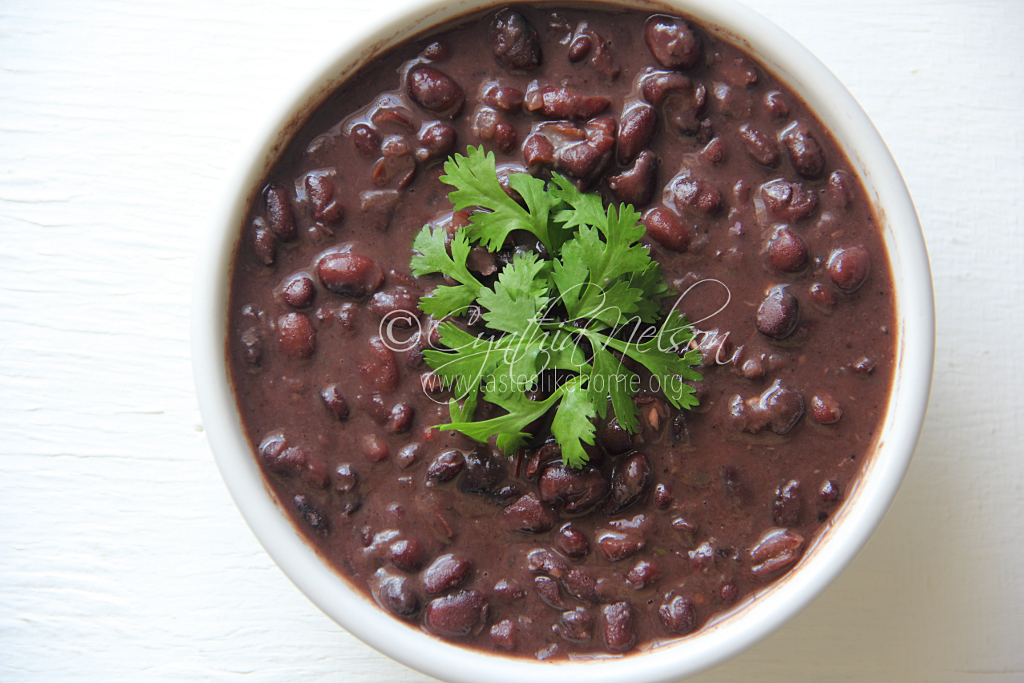
There are certain peas and beans that we prefer to cook with and use to make specific dishes, but if it is one thing we are to learn, it is that we must adapt. Adapting is not new to us; our history is replete with evidence of such. Perhaps we have gotten so accustomed to having certain things readily available to us that we have become stuck in our ways.
While shopping the other day, a couple saw me picking up a packet of black beans and asked me what I was going to make with it. They had never used/cooked it before but were considering getting it given the scarcity of other peas and beans. Therefore, I thought I’d share with you, as I did with them, one of my favourite ways to have black beans: stewed.
In conversation with the couple, I mentioned two familiar ways in which Cubans cook and eat black beans: stewed and eaten with white rice, or cooked as a one-pot dish of rice and beans. I also mentioned Trinidad and Jamaica’s making of stewed beans using Kidney beans and that black beans would work just as well.
Black beans have high levels of antioxidants because of their colour and they are capable of fulfilling about half of our daily recommended intake of dietary fibre. We all know that a diet high in fibre is beneficial in multiple ways. High in protein, black beans are filling; when you eat them they have a good mouth-feel that can curb your hunger. Black beans are an excellent source of folic acid (folate). Folate is a B-vitamin that plays an important role in the production of red blood cells; it is a particularly important nutrient for pregnant women.
Apart from the nutritional benefits, black beans taste exceptionally good. They stand up to long cooking, can take on robust flavours and be mixed and matched with many other ingredients. One of my favourite ways to eat black beans is stewed, and for quick cooking I use a pressure cooker.
When I make stewed beans or peas, I tend to make a big pot of it so that I can have it at various times during the week. 1 cup of dried legumes when rehydrated will give you 2 cups (twice the amount).
Here’s how I make my Stewed Black Beans. Start by planning ahead and soaking the beans overnight.
INGREDIENTS
· 2 cups dried black beans soaked overnight (this will yield 4 cups rehydrated beans)
· 4 tablespoons oil
· 1 cup finely chopped onions
· 2 tablespoons chopped fresh thyme
· Minced hot pepper to taste
· 1 tablespoon finely minced garlic
· 1 heaped tablespoon ground allspice
· 3 whole cloves
· Salt and black pepper to taste
· Lukewarm water
· Fresh coriander/cilantro (optional)
DIRECTIONS
1. Drain off the water in which the beans were soaking, and rinse and drain them well. Set aside.
2. Add the oil to a pot and place on medium heat until hot.
3. Add onions, thyme, and pepper, stir to mix, reduce heat to low and cook until fragrant and the onions have softened.
4. Raise the heat to medium and add the garlic, allspice, and cloves, cook until fragrant (about 2 – 3 minutes).
5. Add the drained beans, stir to mix, and add salt and pepper to taste. Cook for 3 minutes.
6. Pour in enough water to cover the beans by 1-inch. Bring to a boil cover and close pressure cooker. If using a regular pot, cover and bring to a boil (you will need to add more water to the pot to cover more than an inch).
7. When the pot comes up to pressure, reduce the heat to low and cook for 15 minutes. Release the pressure and check if the beans are cooked, they should be soft but not mushy. If they are not soft, replace the lid and pressure for a period of time you think will be adequate for the beans to become soft. When the beans are soft, raise the heat to medium high, taste for seasoning and adjust if necessary; using the back of a spoon, mash some of the beans to make the stew thick and creamy. You may need to let it cook uncovered for a few minutes to your desired consistency. (If you are using a regular pot, let the beans simmer for half an hour before checking and following with the rest of the directions).
8. Garnish with fresh cilantro/coriander and serve as a soup by itself or ladled over rice, or with bread, dumplings, ground provisions etc.
NOTE
· You can add a piece of salted meat – beef or pigtail – to season the stew, eliminating the need for salt.
Get more out of the beans if you have leftovers. Here’s what to do: puree leftovers with a little bit of sour cream or yogurt to make a dip or spread for wraps or sandwiches. Or puree the leftovers, transfer the mixture to a bowl, grate cheese – mozzarella or cheddar – microwave for a minute or until cheese melts and stir together to make a cheesy-bean dip/spread.
Enjoy!
Cynthia
cynthia@tasteslikehome.org






